The Smith & Wesson Model 317 Kit Gun is a perfect choice for sportsmen spending the day in the field. Much like a compass or a knife, a kit gun is a tool of necessity for anyone camping, on a hike, or out fishing.

U.S.A. –-(Ammoland.com)- Often times I start off a gun review by stating my initial impressions and general pleasantries around a given product and a rough allusion to how said product performed. The idea is that you would then read the rest, taking in the points of my vague introduction as I describe the various selling points of the gun or gear in question. This review is something a bit different than what I usually do because this is a gun that deserves a different set of criteria to grade it. I think you’ll be surprised.
Smith & Wesson Model 317 Kit Gun
At first glance, the feathery Smith and Wesson 317 .22LR Kit Gun doesn’t immediately catch the eye. It is a rather common-looking revolver, and it could be said that it has all the features of the quintessential wheelgun, but none that stand out from the crowd visually. It really isn’t a target gun. It isn’t a very powerful weapon for self-defense. It is larger in the grip and barrel than other J-Frames, which makes it a less desirable carry gun than other options in the same frame size. It is, however, not a gun that you are ever likely to sell once you buy it. Plan on this gun being a friend for life.
How is it that this gun is one that you would end up keeping for life if it isn’t really good for much in today’s enlightened, high-speed thinking? The simple answer is that this is a tool of endless utility; the features and caliber make it a gun that you will, in all likelihood, pass on to your son or daughter. In today’s fast-paced world of nines and boutique 6.5’s, it is easy to overlook the guns that you would actually use in real life in their intended role, despite the fact that you may not fire them much at all.
Today’s 317 Kit Gun has its roots far back in Smith and Wesson history. There are probably a fair number of you that have never heard of the old I-Frame. This frame size is no longer manufactured and it was the precursor to the J-Frame. The J-Frame is, of course, one of the most popular classes of weapon in use in American today and is incredibly diverse in terms of features and caliber offerings.
The 317 I received features mostly aluminum construction, a HI-VIZ front sight, adjustable rear, full-size grip, and a 3” barrel. These are ideal stats, and the gun balances and points easily. Accuracy was to be expected from a Smith and Wesson. 2-3” at 25 yards was an all-day occurrence with any ammo I had on hand. This was, in point of fact, the least interesting part of this gun review. S&W makes such a good revolver that I sometimes wonder if it is even necessary for me to go to the range with them at all due to the fact that the results are always stellar.
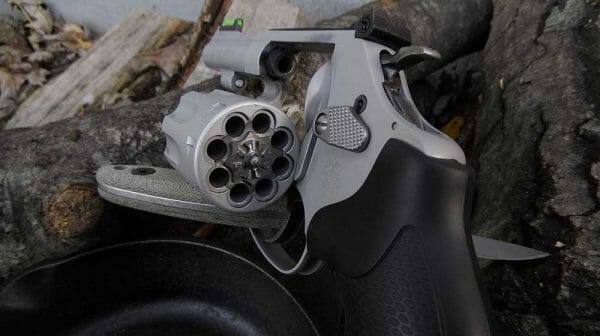
Now, on to a bit of history on the Smith & Wesson Model 317 Kit Gun
Back in those old days of years past, those golden years of our treasured past, it was common for a sportsman to have a handgun among his camping and hunting gear or in his fishing kit, which earned this type of pistol the title of Kit Gun. Although the term was broad and many guns were considered under that definition, most people who study the topic, myself included, tend to think that the definitive Kit Guns were .22LRs.
Today we have a wealth of options available to us as sportsmen and enthusiasts. There are quite literally thousands of individual products that cater to the outdoorsman. The sad fact of the matter is that there aren’t very many guns that fit in with demands of the modern, need-based individual. Ideally, a gun that is made for this type of work, be it that of a tradesman working outside on remote sites or a fairweather weekend camper, would be essentially a tool for use that is ready when it is called on, just like a saw or mallet. The Kit Gun fits this role perfectly, as it weighs hardly ¾ of a pound loaded with eight rounds and is nearly impervious to the weather, just like a hard-use tool should be.
The idea of a .22LR Kit Gun goes back all the way into the very heart of the American outdoor culture and is one of the categories of gun that can somehow cross political and social barriers. When I began this review, I got the typical banter from my peers about how the gun is fun, but not serious like a larger caliber and is essentially a range toy. I scoffed and decided to do my review in the typical way until I was shooting the breeze with a waitress I see occasionally when I go to type at the bar. She is decidedly anti-gun and I usually never talk to her about my job. Our common ground is that we both like the outdoors and photography. Imagine my surprise when, while showing her the photos for this article, she uttered a phrase I never thought I would hear.
“I have that one. That pistol there.”
“Shut up.”
“No, seriously. I have it for hiking, but I didn’t want to tell you I had one. It’s really the same thing as a compass or a knife. It’s not like those other guns you write about. Nobody uses those big guns out there.”
This was pretty surprising to me and I decided, upon her insistence, to look further into this.
I randomly surveyed fifty outdoor people at sports retailers upon beginning this article. They ended up including pro-2A folks, centrists, and avowed anti-gun types and found that nearly all of them, even the hardest and most outspoken gun grabbers in the bunch, owned and regularly carried a .22LR. Most commonly it was a double or single action revolver they brought with them camping. Being a friendly guy, and equally outspoken critic of hypocritical action of the part of my contemporaries, I asked why they had and used them. The answer I received is that a .22LR in a revolver is, to paraphrase, ‘part of the deal’ when it comes to hiking and camping.
An interesting note of difference between the victims of my survey, most pro-2A people owned a gun that filled the role of a Kit Gun, but it wasn’t a regularly used item in their collection. The most common camp guns today in their hands are, not surprisingly, an AR-pattern rifle and a 9mm. One of the prompts in my survey asked if a .22LR was a good minimum caliber for campers and trail hikers. Pro-2A folks automatically said no, opting for a somewhat hyperbolic minimum of .44 Magnum. To make things interesting, I asked how often they carry a .44 Mag on the trail. Not one had. My native state of Michigan isn’t exactly teeming with predators like grizzlies, which makes their choice even more obnoxious.
On the other hand, the casual hikers without political end goals, as well as the self-identified anti-gunners, viewed the .22LR as an essential item for the woods. This was very evident to me in one particular point of view: the uses of the gun. The individuals that identified as pro-2A unanimously put down ‘self-defense’ as a reason to carry a gun on the trail. This, I believe, is a cultural difference that spawns from the central tenants, and dogma, of this culture. Every other camper and hiker listed something to the tune of signaling, emergency hunting, weight considerations, ammo weight and variations, and as camp pest control.
You may think that I am getting off topic with all these surveys and such, but I must stress that this is about the 317 Kit Gun. I told you that this would be a different article and I’m not just reviewing a gun here like some tabletop YouTube hack. This is important stuff because it is cases like this that can really show what a diverse gun culture looks like in today’s America.
I specifically targeted fifty different ‘gun people’ and asked them questions designed to illustrate their ideas about .22LRs on the trail.
- What is your ideal trail gun? How much ammo do you carry? Why do you carry it?
- How much time/how many miles do you camp/hike regularly?
- What items do you consider indispensable on your adventures?
- How much gear do you carry and how much does it weigh?
- Do you hunt or fish on the trail/at the camp?
- Do you feel secure in your choices for this gear?
Question one resulted in mixed answers. I had originally intended the question to be a ‘one gun’ kind of thing, but every gun person wanted to have more than one gun and all wanted to carry about 100 rounds total. Several AR owners stated 2-300 rounds. Out of fifty, only two said a .22LR was ideal. Self-defense in the woods was the most common answer for all. Of the twenty-two individuals that only wanted to carry a handgun, most selected either a .357 Mag, .44 Mag, 9mm, or .45ACP. I was surprised that people felt so vulnerable in the woods.
Of the fifty individuals in this group, none spent more than a few weekends a year at camp. Most stated that they spent less than 50 miles on a trail in the last year. Only two stated that they logged more than 100 miles on the trail in a year. All the individuals surveyed stated that they were avid outdoorsmen.
Indispensable items? You’d better get out your Cabela’s card, friends. Most wanted items that were pricey and, to be honest, unnecessary. Items like tents, water filters, and essential survival items were low on the list and far below ‘big knives’ and ‘paracord’. First aid kits only appeared in five cases. I would say that this dovetails right into the ‘how much gear’ category. This demographic is obsessed with gear. When it is all said and done, some of this group alleged to have carried as much as 100 pounds in their pack!
All fifty said that they hunt and fish on the trail, which wasn’t a surprise. How they managed to get out to their stand with 100 pounds of gear, two guns, and ten mags has yet to be discovered.
Finally, I asked if they felt comfortable with their gear. Most explained that they wanted different things and that their gun wasn’t powerful enough. I came to the conclusion that, despite my own affiliations, gun people weren’t all that trail and stream savvy. In fact, being on the trail and being outdoors was simply an excuse to carry guns, not the other way around. I think this has to do with the cultural differences I mentioned earlier. The experience is centered around the peripheral objects, not the existential state of being in the woods. In short, this group cannot see the proverbial forest through the trees.
The other group I targeted was self-described non-gun types, but still the owner of a gun like my waitress friend. I know that you’re scratching your head on this, but there are plenty of people who own and use guns that aren’t and don’t want to be part of the culture at large.
Fifty individuals in this category were asked the same questions as above. Ideal gun for their outdoor time? A compact .22LR with about three fifty-round boxes of ammo. Most (34/50) either owned or wanted a revolver. None wanted anything to do with a rifle because of weight and size factors. The other most desirable calibers were .38 Special and .22 Magnum.
Miles traveled and hours camped? This group had an average of 5-600 miles hiked annually, with some outliers as high as 2,000. One woman claimed to go through two pairs of hiking boots a year and the guy at the sales counter confirmed this. Most individuals also camped and fished on the trail, while only four claimed to hunt on the trail or camp.
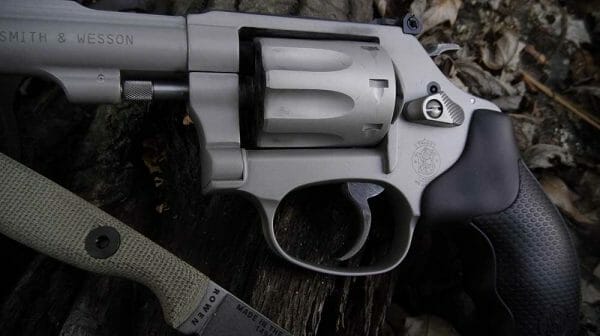
The most common uses for a gun on the trail were signaling, emergency use, and camp protection. Ease of use and low recoil were also stated as pluses. In addition to a gun, a small fixed-blade knife was seen as essential.
The ESEE brand was held in the highest regard and was mentioned by name enough that I had to list it here. The knife featured in this article’s photography is the ideally-sized ESEE Camp-Lore CR2.5. This is a wonderful knife and nicely compliments any kit bag. I was a bit skeptical about the size, but the CR2.5 is a hell of a knife and I’ve found that it is now a regular companion on my coyote hunting afternoons, gardening tasks, and has even made appearances at dinner around the campfire. ESEE makes what are probably the best knives available and they’re made in the USA, which is a huge plus in my book.
As far as other gear is concerned, weight and ease of use were factors. Indispensable items included a small tent or hammock, water purification tools, first aid items, and wilderness survival items like firestarters and a compass.
All said and done, the average load for this group was under 40 pounds, which is a 60+ pound savings over the other group.
My conclusions to this survey were pretty rattling to me. The people I considered serious outdoorsmen, the guys wearing camo all the time and driving around big trucks, were embarrassingly novice compared to their Volvo-driving, latte-sipping counterparts. How is it that the individuals that profess their love of the outdoors are so shamefully outclassed? I think that the answer is obvious. The individuals that are buying guns like the Smith & Wesson Model 317 Kit Gun aren’t interested in taking it to an IDPA match and getting yelled at by some old range guy or proving their masculinity by means of bullet diameter. They are interested in buying a tool for the trail, river, or camp that is 100% dependable, simple, and light to the point of being indispensable.
I said earlier that the Smith & Wesson 317 Kit Gun is a gun for life. The reason I say that may be clear to you now. You’ll find no better gun for an active lifestyle and no closer friend for the trail and camp. There are other options and plenty of available gear, but do yourself a favor and get yourself a gun that you will actually use and carry all the time. I guarantee that you’ll find yourself enjoying nature far more when you’re not worried about this year’s newest wonder-nine or 1,500 yards 6.5 make-believe sniper rifle.
Smith & Wesson 317 Kit Gun
 About Josh Wayner:
About Josh Wayner:
Josh Wayner has been writing in the gun industry for five years. He is an active competition shooter with 14 medals from Camp Perry. In addition to firearms-related work, Josh enjoys working with animals and researching conservation projects in his home state of Michigan.

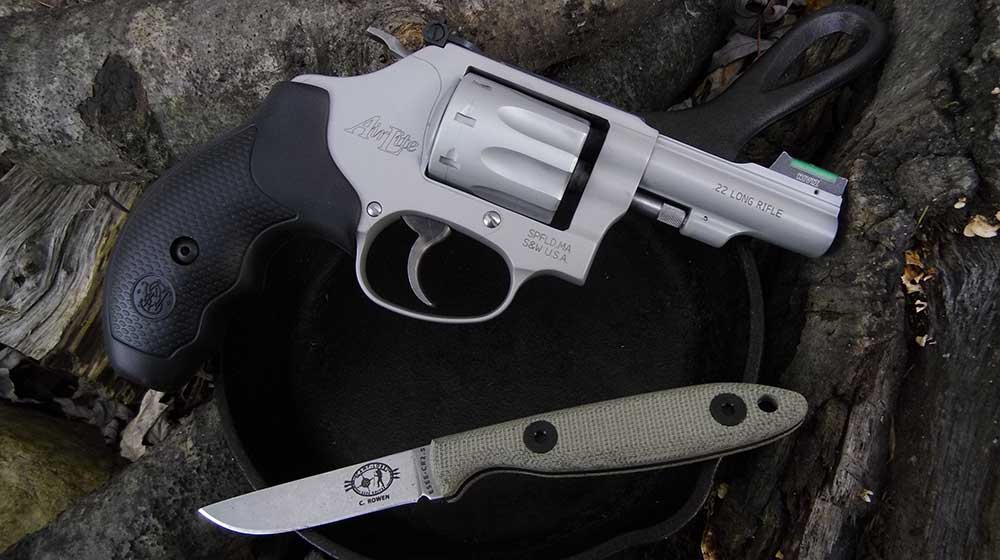
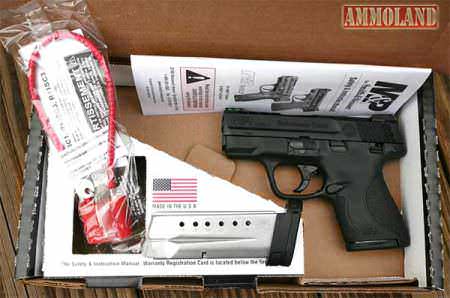
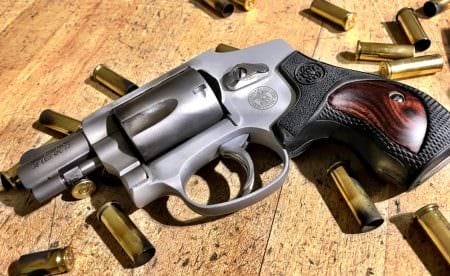



@GDubb: This may astound you but not everyone lives where you do! In fact most don’t so why are you intent with trying to find fault with someone who just wanted to write an interesting article? Tell ya what, you write an article, submit it to Ammoland and then let the rest of us pick at it like buzzards.
Worthless as a “hiking gun” in many areas here in the West. If it can’t kill a bear it is not worth the bringing along. I believe it would struggle to even kill a cougar with one cylinder. Not a reliable solution in my mind. Yes I bring nothing smaller than .45ACP +P when I go out into the wild. Every time.
While not a camper since my Boy Scout days, many decades ago, this was a fascinating article. It’s not just a gun for on the trail/camping though. After carrying a Glock for up to 18 hours a day for almost 30 years I now enjoy slipping a 22 in my jacket when I walk my dog through the fields or woods every day.
Thanks for a really fun read.
Good analysis. I have a 60s era model 63 no dash as well as a 317. Although you can’t beat the proverbial glass rod crispness of the old model 63, the eight shot cylinder and light weight of a 317 mean I use it more often. And maybe, just maybe, the addition of the geezer friendly hi-viz sight system make it a bit easier on the eyes as i enter my seniority.
Very well researched and written article. I appreciate the way the author went beyond the typical statistical data of the gun but put it into context of real life use and the even broader lifestyle discussion. I wish we could see more of this and less of the “movie” style of reviews. It shouldn’t always be simply a thumbs up or thumbs down for everything.
Seriously good read. Way to illustrate the differences in the culture and not be afraid to point out that “non-gun people” might actually know more about a practical gun choice than those that are self proclaimed gun experts.